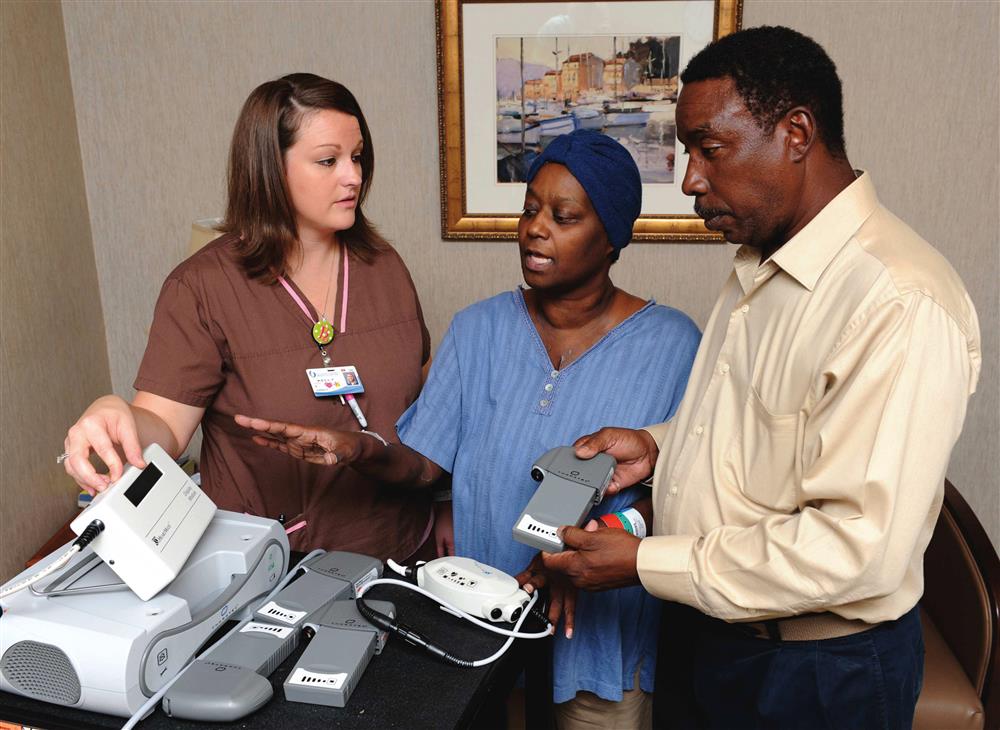UMHC LVAD team gives gift of time to Tupelo heart failure patient

A University of Mississippi Health Care surgical team placed the state's first implantable left ventricular assist device (LVAD) in Jackie Kirkman of Tupelo, improving her chances for an eventual heart transplant.
The LVAD, called a bridge to transplantation, is a mechanical blood pump that assumes some of the work for the heart. It's reserved for end-stage heart failure patients who have run out of other lifesaving options.
With the shortage of donor organs, it's possible to maintain and stabilize transplant patients with this device for a longer period of time.
"It will allow our patients to become stronger while they're waiting for a heart transplant and keep them alive longer so they can have a transplant eventually," said Dr. Curt Tribble, professor of surgery and lead surgeon for Kirkman's procedure.
Kirkman, 43, was seriously ill when she arrived at UMMC on Aug. 3. Her body was bloated and her skin was discolored from poor blood circulation. Her unexplained (idiopathic) cardiomyopathy had weakened her heart muscle so much that she couldn't complete a sentence without shortness of breath. She needed assistance to walk and she spoke in a barely audible whisper.
"She thought she was talking loudly but she was whispering. She was so sick," said her fiance, Andy Elzie, Jr.
After Kirkman's cardiologist in Tupelo, Dr. Karl Cossen, realized traditional medical therapy wasn't working and her condition was deteriorating rapidly, he referred her to Dr. Charles Moore, associate professor of medicine at UMMC. Kirkman had been on continuous intravenous medication for weeks.
She's on the UMMC heart transplant waiting list, but her condition made her too weak to survive the surgery and the immunosuppression required to prevent rejection of the organ.
"That's the type of patient for which the left ventricular assist device seems appropriate," Moore said.
Following the surgery and several weeks of recuperation in the hospital, Kirkman now smiles when asked how she feels.
"I'm almost ready to run a marathon, I feel so good," she said.
Kirkman has been discharged from the hospital, but she will live in Jackson for the next month until doctors here feel she's recovered enough to return home to Tupelo, where her cardiologist and Moore will monitor her progress.
Detailed planning with a multidisciplinary team is central to the success of the LVAD program, which includes surgery, follow-up care, patient education and community medical training. The program requires a team both at the Medical Center and in the patient's community.
UMMC staff trained Tupelo emergency medical personnel how to care for the patient if called to respond. The emergency room staff learned what to do once the patient arrives at the hospital. LVAD patients don't respond to traditional lifesaving measures, such as chest compressions, because of the continuous heart pump.
Also, a letter went to Kirkman's power company to make sure she's at the top of the list for restoration of electricity in case of outages. That's because the LVAD is battery-operated and the batteries must be charged regularly.
The Medical Center has offered LVAD in the past with an older model of the device that required patients to stay in the hospital. Early models of LVAD were large, cumbersome and placed outside the body.
The technology has improved over time, becoming smaller, more easily implantable and easier to remove.
"The potential improvement in lifestyle is substantial. Patients have limitations, however," Moore said. "They have to be near a power source. There's a risk of infection through the drive line and they also have to take blood thinners to prevent blood clots and strokes."
The LVAD is attached to the heart and an external tube connects to a battery that can be stored in a pouch similar to a "fanny pack" or a shoulder bag.
In addition, the FDA has approved the device for use as destination therapy. This therapy is for patients who may not be a candidate for transplant, perhaps because of underlying medical conditions or age, but may qualify for LVAD to improve their quality of life.
Tribble said the program's goal is to offer the LVAD as destination therapy at some point in the future.
"It makes sense that this be a part of a tertiary care center where there's a multidisciplinary team in place to care for the patients," said Tribble, noting more than 100 people were integral to Kirkman's care.


